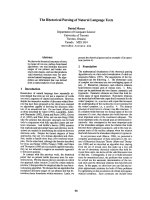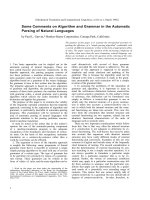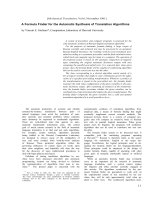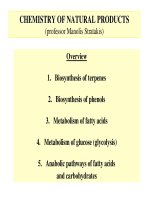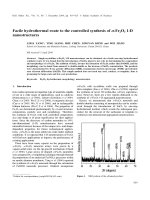Volume 1 the total synthesis of natural products
Bạn đang xem bản rút gọn của tài liệu. Xem và tải ngay bản đầy đủ của tài liệu tại đây (20.24 MB, 609 trang )
Total Synthesis OfNatural Products, Volume1
Edited by John Apsimon
Copyright © 1973 by John Wiley & Sons, Inc.
THE TOTAL SYNTHESIS
OF NATURAL PRODUCTS
Total Synthesis OfNatural Products, Volume1
Edited by John Apsimon
Copyright © 1973 by John Wiley & Sons, Inc.
The Total Synthesis
of Natural Products
VOLUME 1
Edited by
JOHN ApSimon
Department of Chemistry
Carleton tmiuersify, Ottawa
WILEY-INTERSCIENCE, a Division of John Wley & Sons, Inc.
New York -.London .Sydney
Toronto
A NOTE TO THE READER
This book has been electronically reproduced from
digital information stored at John Wileydr Sons, Inc.
We are pleased that the use of this new technology
will enable us to keep works of enduring scholarly
value in print as long as there is a reasonable demand
for them. The content of this book is identical to
previous printings.
Copyright @ 1973 , by John Wiley & Sons, Inc
All rights reserved. Published simultaneously in Canada.
Reproduction or translation o f any part of this work beyond that
permitted by Sections 107 or 108 o f the 1976 United States Copyright Act without the permission of the copyright owner is unlawful. Requests for periiii~nionor further information should be
addressed to thc Permissions Departnient. John Wiley & Sons. Inc.
Library of Congress Cataloging in Publication Data:
ApSimon, John.
The total synthesis of natural products.
Includes bibliographical references.
1. Chemistry, Organic-Synthesis. 1. Title.
QD262.A68
547l.2
ISBN 0-471-03251-4
12-4075
Printed in the United States of America
I0 9 8
Contributors
to Volume 1
U.
F.
A.
F.
J.
Axen, Upjohn Company, Kalamazoo, Michigan
M. Dean, University of Liverpool, England
H. Jackson, University College, Cardiff, United Kingdom
Johnson, Dow Chemical Company, Wayland, Massachusetts
K. N. Jones, Queen’s University, Kingston, Ontario
S. A. Narang, National Research Council of Canada, Ottawa
J. E. Pike, Upjohn Company, Kalamazoo, Michigan
W. P. Schneider, Upjohn Company, Kalamazoo, Michigan
K. M. Smith, University of Liverpool, England
W. A. Szarek, Queen’s University, Kingston, Ontario
R. H. Wightman, Carleton University, Ottawa, Ontario
Preface
Throughout the history of organic chemistry we find that the study of natural
products frequently has provided the impetus for great advances. This is
certainly true in total synthesis, where the desire to construct intricate and
complex molecules has led to the demonstration of the organic chemist’s
utmost ingenuity in the design of routes usingestablished reactions or in the
production of new methods in order to achieve a specific transformation.
These volumes draw together the reported total syntheses of various
groups of natural products with commentary on the strategy involved with
particular emphasis on any stereochemical control. No such compilation
exists at present and we hope that these books will act as a definitive source
book of the successful synthetic approaches reported to date. As such it will
find use not only with the synthetic organic chemist but also perhaps with the
organic chemist in general and the biochemist in his specific area of interest.
One of the most promising areas for the future development of organic
chemistry is synthesis. The lessons learned from the synthetic challenges
presented by various natural products can serve as a basis for this everdeveloping area. It is hoped that this series will act as an inspiration for
future challenges and outline the development of thought and concept in the
area of organic synthesis.
The project started modestly with an experiment in literature searching by
a group of graduate students about six years ago. Each student prepared a
summary in equation form of the reported total syntheses of various groups
of natural products. It was my intention to collate this material and possibly
publish it. During a sabbatical leave in Strasbourg in the year 1968-1969,
I attempted to prepare a manuscript, but it soon became apparent that if 1
was to also enjoy other benefits of a sabbatical leave, the task would take
many years. Several colleagues suggested that the value of such a collection
vii
viii
Preface
would be enhanced by commentary. The only way to encompass the amount
of data collected and the inclusion of some words was to persuade experts in
the various areas to contribute. I am grateful to all the authors for their
efforts in producing stimulating and definitive accounts of the total syntheses
described to date in their particular areas. I would like to thank those
students who enthusiastically accepted my suggestion several years ago and
produced valuable collections of reported syntheses. They are Dr. Bill
Court, Dr. Ferial Haque, Dr. Norman Hunter, Dr. Russ King, Dr. Jack
Rosenfeld, Dr. Bill Wilson, Mr. Douglas Heggart, Mr.George Holland, and
Mr. Don Todd. I also thank Professor Guy Ourisson for his hospitality
during the seminal phases of this venture.
JOHN APSIMON
Ottawa, Canada
Febrrtary 1972
Contents
The Total Synthesis of Carbohydrates
1
J. K. N. JONESand W. A. SZAREK
The Total Synthesis of Prostaglandins
u. AXBN,J.
E.
PIKE, AND
w. P. SCHNEIDER
The Total Synthesis of Pyrrole Pigments
81
143
A. H. JACKSON AND K. H. SMITH
The Total Synthesis of Nucleic Acids
s. A.
NARANG
AND R. H.
279
WIGHTMAN
The Total Synthesis of Antibiotics
331
F. JOHNSON
The Total Synthesis of Naturally Occurring Oxygen Ring Compounds 467
F. M. DEAN
Subject Index
563
Reaction Index
597
ix
THE TOTAL SYNTHESIS
OF NATURAL PRODUCTS
Total Synthesis OfNatural Products, Volume1
Edited by John Apsimon
Copyright © 1973 by John Wiley & Sons, Inc.
The Total Synthesis
of Carbohydrates
J. K. N. JONES AND W.A. SZAREK
Department of Chemistry, Queen's University, Kingston, Ontario, Canada
1. Introduction
2. Base-Catalyzed Condensations with Carbon-Carbon Bond Formation. The
Formose Reaction
3. Syntheses from Acetylenic and Olefinic Precursors
4. Syntheses from Tartaric Acid and Other Naturally Occurring Acids
5. The Diels-Alder Reaction
6. Syntheses from Furan and Pyran Derivatives
7. Miscellaneous Syntheses
A. Amino Sugar Derivatives
B. Deoxyfluoro Sugar Derivatives
C. Branched-Chain Sugars
8. Enzymic Syntheses
9. Synthesis of Cyclitols
References
1
2
8
19
24
28
58
58
60
62
64
66
75
1. INTRODUCTION
The carbohydrates comprise one of the major classes of naturally occurring
organic compounds. Although the structures of carbohydrates appear to be
quite complex, the chemistry of these compounds usually involves only two
kinds of functional group, ketone or aldehyde carbonyls and hydroxyl
groups. The carbonyl groups normally are not free but are combined with
1
2
The Total Synthesis of Carbohydrates
the hydroxyl groups in hemiacetal or acetal linkages; the carbon of the
“masked” carbonyl is known as the anomeric center. When a free sugar is
dissolved in an appropriate solvent, a dynamic equilibrium is achieved
involving both anomerization and ring isomerization.
A wide variety of sugars has been found in nature and/or synthesized in
the laboratory. These include not only the “classical” sugars but also
derivatives such as amino, thio, halo, deoxy , branched-chain, and unsaturated sugars. Most synthetic sugars have been obtained by chemical
transformations of naturally occurring sugars or their derivatives. In fact,
the degree of achievement is such that the synthesis of a new mono-, di-, or
trisaccharide can now be undertaken with a fair degree of confidence.
The total synthesis of sugars from noncarbohydrate precursors has also
been achieved by many routes. Some methods are long, involved, are
stereospecific and result in the formation of one or two sugars only; others
are relatively simple but produce complex mixtures of carbohydrates which
may resist fractionation. Practically all naturally occurring sugars are
optically active. Most synthetic routes which employ noncarbohydrate
precursors produce racemic mixtures of sugars which may be difficult to
separate into the D and L isomers. However, if enzymes are used to effect
condensation of fragments or to remove one or more of the components,
optically pure isomers may be isolated. In this chapter the total synthesis of
sugars and the. related alditols and cyclitols, from noncarbohydrate substances by both specific and nonspecific methods, are discussed. Only
compounds containing more than three carbon atoms are considered.
2. BASE-CATALYZED CONDENSATIONS WITH CARBON-CARBON
BOND FORMATION. THE FORMOSE REACTION
The formose reaction has attracted the attention of biologists and chemists
in recent years because it involves the self-condensation of formaldehyde to
produce reducing sugars. This property is of interest in considering the
problem of the origin of life on this planet, especially as formaldehyde has
been detected in interstellar gases,‘ and also because of the feasibility of
using carbon (as formaldehyde) as a possible source of sugars for the growth
of microorganisms with the concomitant production of proteins and other
complex organic compounds of importance to life and industry.2
The self-condensation of formaldehyde under the influence of base to
yield a sugarlike syrup (methylenitan) was first observed by ButlerowS in
1861, when he treated trioxymethylene with calcium hydroxide solution.
Calcium carbonate, magnesia, baryta, mineral clay, or even y-radiation
2. Base-Catalyzed Condensations
3
may also be used.4 Fischer5 showed that the sugarlike syrup called formose
obtained from gaseous formaldehyde,“ or methose prepared by the action
of magnesium hydroxide suspension on formaldehyde,’ contained monosaccharides, and that by reacting methose with phenylhydrazine acetate it
was possible to obtain two hexose phenylosazones in low yield. Much higher
yields were obtained from acrose (see below). Fischer named these derivatives
a- and ,9-acrosazone (the corresponding sugars are a-acrose and 8-acrose)
and showed that a-acrosazone was DL-arabino-hexose phenylosazone (DLglucose phenylosazone). In a remarkable series of experiments involving
chemical and enzymic processes, Fischer was able to achieve the total
synthesis from a-acrose of D- and L-glucose, D-gluconic acid, D- and Lmannose, D- and L-mannonic acids, D- and L-mannitol, and of D- and
L-arabino-hexulose (D- and L-fructose), thus laying the basis for the synthesis
of many other sugars. The transformations achieved are shown in Scheme 1.
8-Acrosazone was later identified as DL-xylo-hexose phenylosazone
(DL-sorbose phenylosazone), which can be derived from DL-glucose, DL-idose,
and ~~-xylo-hexulose
(DL-sorbose).8 However, there has been a suggestion
that ,9-acrosazone is really the phenylosazone of DL-dendroketose (see
below). Fischer and TafeP observed that 2,3-dibromopropionaldehyde
(acrolein dibromide) when treated with dilute alkali yielded products which
reacted like sugars (hence the name “acrose”). DL-GlyceraldehydelO also
gave products that possessed the properties of sugars when treated similarly.
Fischer and TafelS explained the formation of acrose as an aldol-type condensation between DL-glyceraldehyde and lY3-dihydroxypropanone (dihydroxyacetone), the latter compound being formed by a base-catalyzed
isomerization from DL-glyceraldehyde (see Scheme 2).
H. 0.L. Fischer and E. B a e P showed that D-glyceraldehyde and 1,3dihydroxypropanone react in basic solution to yield D-arabino-hexulose and
D-xylo-hexulose as major products. This reaction is a general reaction and
novel sugars can be produced if D-glyceraldehyde is replaced by L-glyceraldehyde or by other aldehydes (see below). It is interesting that the biological
origin of D-arabino-hexulose follows a similar route, but sugar phosphates
and enzymes (aldolases) are involved.12 In all cases the threo configuration is
favored at the newly formed asymmetric centres but condensations involving
enzyme-catalyzed reactions13 usually yield the D-threo configuration only.
The conversion of formaldehyde to formose involves a complex series of
reactions which have been rationalized by Breslow,14 who suggested that
two processes are involved in the formation of glycolaldehyde from formaldehyde. The first is a slow condensation of two molecules of formaldehyde
to form glycolaldehyde, which then reacts rapidly with a further molecule of
formaldehyde to produce glyceraldehyde. Part of this is then converted to
P
4
R
R
I
HOCH
I
COOH
D-arubino-Hexose
phenylosazone
conc. HCI
R
D-Mannose
I
HC-
Scheme 1
I
1
zn
yeast
I
I
L-Fructose
(only the D isomers of
DL mixtures are shown)
CHzOH
I
HCOH
I
HCOH
R = HOCH
DL-Mannitol
I
R
CH,OH
lNa-Hn
I
a HOCH
D-Fructose
r-Mannose
yeast
DL-Mannose
R
R
I
Dr-Fructose
AcCH
1
C=O
CH,OH
- Zn
(DL-urubino-Hexosulose,
DL-Glucosone)
D-arabino-Hexosulose
-
I
I
HC=O
HOCH
\Na-Hn
~-Gluconicacid
R
I
I
COOH
auinoline A
R
a-Acrosone
Z H O C H
D-Mannonic acid Dr-Mannonic acid
Na-Hg
PhNHNHz
i
D-Glucose
I
resolved via strychnine sal~s
HCOH -HCOH
I
I
HC=O
L-Mannonic
acid
R
H G O
I
conc.HCI
I
C=NNHPh + C=O
I
I
HC=NNHPh
a-Acrosazone
(DL-urubino-Hexose
phenylosazone
Formaldehyde,
PhNHNH,
glyceraldehyde or + a-Acrose *
acrolein dibromide
2. Base-Catalyzed Condensations
HC=O
I
CHBr
I
HC=O
+
CH,Br
CHZOH
I
C=O
I
CHzOH
HCOH
I
II
CHOH e COH
I
I
one
CHzOH
+
CHZOH
I
e C=O
I
CH,OH
HC=O
5
CHzOH
CH,OH
I
I
OH'
CHOH --+
C=O
CH,OH
CHOH
I
HZ0
I
I
I
CHOH
I
CHOH
CH,OH
Scheme 2
1,3-dihydroxypropanone,* which then rapidly reacts with formaldehyde to
yield tetrulose and then tetrose, which then breaks down to two molecules
of glycolaldehyde. The reaction is thus autocatalytic and is formulated as
shown in Scheme 3. The rate of formose forfiation is dependent upon the
metal cation of the base used. It is more rapid with those bases that form
chelate compounds with enediols, which are intermediates in the foregoing
reaction: thallium hydroxide > calcium hydroxide > sodium hydroxide. It
follows that the composition of formose will depend upon the base used, the
concentration of the reactants, and the temperature and time of reaction.
Short periods of reaction favor the formation of lower molecular weight
ketose sugars, longer periods of reaction yield more aldose sugars, while
high concentration of alkali and long periods of heating yield saccharinic
acids16 and other products resulting from the decomposition of sugars by
* 1,3-Dihydroxypropanone has been prepared by Marei and RaphaelI5 from nitromethane
and formaldehyde:
CH,NO,
+xH,o
CH,OH
OH'
---+H O C H , - - L O ,
I
CHZOH
CH,OH
PhCHO
A
H@
OCH
I
2-
HC-OCH,
Ph
I
C-NO,
I
1..
CHZOH
HOCH
2-
C-CHZOH
I1
0
1) NaIO,
t-2)H@
I
OCHZ-C-NH,
I
HC-OCH,
Ph
I
6
The Total Synthesis of Carbohydrates
CH2O
CHZO
+ HOCH2-CHO
+ HOCH,-CO-CH2OH
HOCHZ-CHOH-CHOH-CHO
3 HOCHZ-CHOH-CHO
Z
HOCH2-CO-CHzOH
Z HOCH2-CHOH-CO-CH2OH
Z
HOCH2-CHOH-CHOH-CHO
;+ 2 HOCHa-CHO
Scheme 3
alkali. With the advent of paper chromatography and gas-liquid chromatography, it has been possible to detect all eight aldohexose sugars, all
four hexuloses, the four pentoses, two pentuloses, all possible tetroses,
dendroketose, and three h e p t u l o s e ~ . ~Recently,
~-~~
sugars prepared by
base-catalyzed condensation of formaldehyde were analyzed by combined
gas-liquid chromatography and mass spectrometry; both branched and
straight-chain products weredetected.lgaCannizzaro reaction of formaldehyde
proceeds in alkaline medium in conjunction with the formose reaction to
produce aldoses and ketoses, and it has been shown1Bbthat the extent of the
two reactions is a function of the catalyst used. In a study with calcium
hydroxide as catalyst, it was found that the ratio of branched-chain sugar
derivatives, such as (hydroxymethy1)glyceraldehydeand apiose (see below),
and straight-chain products could be controlled by manipulation of the
reaction conditions. The branched products are very readily reduced by a
crossed-Cannizzaro reaction with formaldehyde and large quantities of
species such as (hydroxymethy1)glycerol are produced. Formose solutions
are decomposed by microorganisms if allowed to stand in an open vessel in
the laboratory.20 Glycolaldehyde itself polymerizes under the influence of
base to yield tetroses, hexoses, and other sugars.21 Methoxyacetaldehyde
polymerizes in aqueous potassium cyanide solution forming 2,4-dimethoxyaldotetroses :22
KCN
CH3OCH2-CHO
CHSOCHZ-CHO
or
+
KaC05
CHSOCHZ-CHOH-CHOCHS-CHO
The polymerization of formaldehyde to yield sugars is, therefore, a very
complicated process. For example, the formation of pentoses from formaldehyde may proceed via several routes. Glycolaldehyde and 1,3-dihydroxypropanone may react to form pentuloses, which subsequently are isomerized
to pentoses, or formaldehyde and a tetrulose may combine to yield pent-3uloses, which then isomerize to pentuloses and pentoses, or glyceraldehyde
and glycolaldehyde may combine to form pentoses. To test these hypotheses,
Hough and Jonesz3 treated mixtures of glycolaldehyde and 1,3-dihydroxypropane and of glyceraldehyde and glycolaldehyde with lime water and
found that pentoses were produced along with several other sugars. They
were able to isolate arabinose, ribose, and xylose, as phenylhydrazones,
from the complex mixture of sugars that results from the two reactions
previously described.
2. Base-Catalyzed Condensations
7
Very recently, it was
that it is possible, by making use of the
hexokinase reaction, to extract some specific sugars from the complex
synthetic formose sugars. The enzyme hexokinase is known to transfer the
terminal phosphate of ATP to D-ghIcose:
D-glucose
+ ATP - D-glucose 6-phosphate + ADP
hexokinase
However, the enzyme is not totally specific for glucose, other hexoses such
as fructose and mannose being also susceptible to phosphorylation. The
basis of the method of extraction involves phosphorylation of some hexoses
by this means, which are then retained on a column of anion-exchange resin
(together with unreacted ATP and formed ADP), while other unreacted,
neutral components of the formose mixture pass through the column. The
sugar phosphates are then eluted by a salt solution of appropriate concentration, and the unsubstituted hexoses are obtained by a phosphatase
reaction.
The branched-chai,n sugar DL-dendroketose mentioned earlier was first
isolated by Utkin,24 who prepared it by adding sodium hydroxide to a
solution of 1,3-dihydroxypropanone in water. It is formed so easily and in
such high yield that it seems remarkable that it has not appeared in any
natural product. Moreover, it is metabolized completely by baker's yeasLZ6
Like the branched-chain sugar apiose,26hemiacetal formation results in the
formation of a new optically active center with the possible formation of eight
isomers from the D and L forms of dendroketose. Utkin was able to isolate
D-dendroketose (4-C-hydroxymethyl-~-glycero-pentulose)
when he observed
that a microorganism which accidentally contaminated a solution of DLdendroketose, metabolized the L-isomer only. He was able to prove the
absolute configuration of the nonmetabolized material by relating it to
~-apiose,Z'a sugar of known absolute configuration, by the series of reactions
indicated in Scheme 4. It may be significant that D-dendroketose, which
remained after fermentation of the DL mixture, possesses a potential L-threo
disposition of hydroxyl groups at C-3 and C-4, while L-dendroketose which
possesses a potential D-rltreo configuration at C-3 and C-4 is metabolized:
CHzOH
I
c=o
I
I
HOCH
~~
HOCHZ-C-OH
I
CH,OH
L-Dendroketose
(metabolized)
CHaOH
I
c=o
I
I
HO-C-CH20H
I
HCOH
CH,OH
D-Dendroketose
(not metabolized)
8
The Total Synthesis of Carbohydrates
CH20H
CH,OH
I
c=o
7
I
I
I
CHOH
HCOH
I
/ \
t
I
I
HCOH
C-OH
/ \
CH20H CH20H
CHzOH CH20H
DL-Dendroketose
D-Dendroketose
CH20H
CO,H
I
fermentation
C-OH
/3
HOCHZ-C
\
I
c-=-o
c=o
H-CHOH
HOO
CH,OH
I
HC=O
8%
t
C-OH
/ \
I
I
HCOH
C-OH
/ \
CHZOH CHzOH CH2OH CHZOH
D-Apionic acid
Me,
o-Apiose
0,
c
P
Scheme 4
3. SYNTHESES FROM ACETYLENIC AND OLEFINIC PRECURSORS
The directed synthesis of carbohydrates from noncarbohydrate precursors in
most cases involves the preparation of compounds of acetylene. These
acetylenic intermediates may be converted into cis- or trans-ethylenic derivatives dependent upon the mode of reduction of the acetylene. A further
advantage of this approach is that the ethylene may then be hydroxylated in
a cis or trans fashion, as decided by the mode of oxidation. In some cases
steric effects may be used to force the predominant formation of one of the
DL forms. This procedure is particularly effective when the hydroxylation
of a ring compound is involved.
3. Synthesis from Acetylenic and Olefinic Precursors
9
Several workers, chief among whom are Lespieau, Iwai, and Raphael,
have synthesized carbohydrate derivatives from acetylenic and olefinic
precursors. Stereochemical problems of hydroxylation were minimized either
by cis-hydroxylation of double bonds of known stereochemistry using potassium permanganate or osmium tetroxide, or by epoxidation of double bonds
of known stereochemistry followed by opening of the epoxide ring, with
resulting trans-hydroxylation of the double bond.
Griner2a appears to be one of the first to attempt the synthesis of sugar
alcohols. He observed that when acrolein was hydrogenated by means of a
zinc-copper couple and acetic acid, dimerization occurred and divinylglycol
(CH,=CH-CHOH-CHOH-CH=CH,)
resulted. This may exist in niem
or DL modifications. Griner obtained the aid of LeBel to isolate a mold
which would preferentially metabolize one of the isomers. I n this, LeBel
was successful. Griner had expected to obtain an optically active material
but obtained a product devoid of activity and concluded that the nieso form
only was present. L e s p i e a ~later
~ ~ showed this conclusion to be erroneous,
Griner attempted to oxidize the divinylglycol, with permanganate solution,
to a hexitol, but was unsuccessful. Later, in a brief note,3O Griner stated that
addition of two molecules of hypochlorous acid to divinylglycol gave a
divinylglycol dichlorohydrin from which, after treatment with base, he
was able to isolate m-mannitol. Lespieau3I repeated the attempted hydroxylation of divinylglycol but used osmium tetroxide-silver chlorate as the
hydroxylating agent, and obtained allitol and m-mannitol (see Scheme 5).
2CH2=CH-CHO
CH20H
I
I
HCoH
AgCIOS
- I
I
HCOH
OSo4
I
HCOH
I
HCOH
CHzOH
Allitol
CH2
pz?
CH,
CH,OH
II
I
HOCH
CH
I
I
HCOH HOCH AgC,OQ HOCH
+ HCOH
I I
HCOH
HCOH
I
I
I
CH
HCOH
CH
II
I
II
II
CH
I
CH2
ttieso
CH2
D-t/itZO
+
( L-//ireo)
1
I ) HOCl
2) @OH
DL-Mannitol
Scheme 5
CH20H
\
CH20H
I
I
HCOH
I
HOCH
I
HOCH
I
HCOH
CH20H
DL-Mannitol
/
10
The Total Synthesis of Carbohydrates
Hence, assuming cis addition of the new hydroxyl groups, allitol arises from
the meso compound and ~ ~ - m a n n i t ofrom
l
Dbdivinylglycol. In a second
method of synthesis,32involving the Grignard reagent derived from acetylene
and chloroacetaldehyde, divinylacetylene dichlorohydrin
(CH,CI-CHOH-C-C-CHOH-CH~Cl),
was prepared, converted to the hexynetetrol, and reduced to the corresponding ethylene derivative. Hydroxylation of the product by means of
osmium tetroxide-silver chlorate gave galactitol and allitol. The ethylene
derivative, therefore, had the meso configuration (see Scheme 6).
Lespiead3 also synthesized ribitol and DL-arabinitol using acrolein
dichloride and acetylene as starting materials as shown in Scheme 7.
Raphael34 improved on these syntheses by using epichlorohydrin and
acetylene as starting materials, and performic acid as the oxidizing agent
(see Scheme 8).
CH,CI-CHO
+ BrMgCrCMgBr + CH,CI-CHO
1
I
CH2CI-CHOH-C-C-CHOH-CH,CI
KOH ( v h diepoxy derivative)
CH,OH-CHOH-C-C-CHOH-CH,OH
1"
Pi-on-starch (Bourguel's C ~ I ~ ~ Y S I )
H H H H
CH2OH-C-C=C-C-CH,OH
AaCIOS
10SO.
CH,OH
CH,OH
I
1
HCOH
HCOH
I
I
HCOH
I
I
HCOH
I
+
HCOH
HOCH
I
HOCH
I
I
HCOH
CH20H
Allitol
CHzOH
Calactitol
&heme 6
\
-
m-Arabinitol
pentaacetate
/
CH,OAc
I
AcOCH
HCOAc
I
I
AcOCH
I
CH,OAc
+
I
I
+
CH,OAc
C'Z
I
I
Ribitol
pentaacetate
Scheme 7
CHZOAC
')%?O,
H2
CH,OAc
CH,OAc
I
I
I
CHOAc
CHOAc
I
t--CHOAc
CHOAc
111
I
C
CH
I!
I
CH
CH2
'
I
I
CHZCI
I
I
I
CHOH
CH,CI
t
CHOH
I
KOH
(via epoxidc)
111
C
CH
&HCI
I
+ CHOH
I
C
CH~OAC
I
I
HCOAc
HCOAc
I
+ HCOAc
HCOAc
I
I
HC=CMMnBr
CH,OAc
kH,CI
I
CHCl
HG=O
HCOAc
AcOCH
8Hz
I1
CH
I
HG==
Ill
CH
12
The Total Synthesis of Carbohydrates
CH,CI
I
I\
HC
- -
CH
C
C
Ill
Ill
I
HCECNa
0
CH
HCO,H
CH
II
CH
I
CH~OH
CH,Br
I
HCOH
I
HCoAc
I
HCOAc
I
I
CHOH
I
CHOH
I
CH20H
CH2Br
I
HOCH
+
CH,OAc
I
I
HCoAc
I
HCOAc
-1
N-bromosuccinimide
I
CH,OAc
CHOAc
CHOAc
I
CH,OAc
D-ribo ( +L-ribo) D-arabirio (+L-arubilro)
IA'OAC
Ribitol
penlaacetate
lA80AC
DL-Arabinitol
penlaacetate
Scheme 8
Iwai and his associates in Japan have achieved several total syntheses of
pentose sugars using acetylenic compounds. Iwai and I w a ~ h i g condensed
e~~
the Grignard reagent derived from 3-(tetrahydropyranyL2'-0xy)-propyne
with 2,2-diethoxyacetaldehyde to yield 1,l-diethoxy-5-(tetrahydropyranyl2'-oxy)pent-3-yn-2-01, which, on reduction with lithium aluminum hydride,
yields the wans-olefin. Catalytic hydrogenation, on the other hand, yields
the cis-olefin. Acetylation of these products, followed by cis hydroxylation
of the double bonds, affords products which, after hydrolysis of the acetal
residues, yield the four DL-pentose sugars (see Scheme 9).
Iwai and Tomita have achieved a stereospecific synthesis of DL-arabinoseS6
and a synthesis of a mixture3' of DL-arabinose and DL-ribose as shown in
Scheme 10.
DL-Ribose has been ~ynthesized~~
stereospecifically by oxidative hydroxylation of 2-ethoxy-5-(tetrahydropyranyl-2'-oxy)methyl-2,5-dihydrofuran
(see Scheme 1 I), which was obtained by hydrogenation of DL-1,1-diethoxy-5(tetrahydropyranyl-2'-oxy)pent-2-yn-4-ol.This acetylenic compound was
prepared by the Grignard reaction of (tetrahydropyranyl-2'-oxy)acetaldehyde
with propargyl diethyl acetal magnesium bromide. One method for the
3. Syntheses from Acetylenic and Olefinic Precursors
+ OHC-CH(OEt),
ROH,C-C=CMgBr
.1
ROHZC-CrC-CHOH-CH(0E
.
r
ROHZC
\
t),
LIAIH,
H
catalyst
(Pd-CaCO,)
CHOH-CH(0Et)z
/
c=c
\
c=c/
/
\
ROCHg
HC=O
I
HCOH
I
HCOH
I
HCOH
I
13
HC=O
HC=O
I
HOCH
+
I
HCOH
I
I
HOCH
HCOH
t.I
I
H OH
HCOH
I
CHzOH
CHzOH
DL-Ribose
DL-Arabinose
CHzOH
DL-XylOSe
CHOH-CH(OEt),
H
HC=O
I
HOCH
+HOCH
I
HCOH
I
CH,OH
DL-Lyxose
Scheme 9
preparation of (tetrahydropyranyl-2’-oxy)acetaldehyde involved ozonolysis
of the tetrahydropyranyl ether of ally1 alcohol. This synthesis of DL-ribose
is the first example, in this chapter, of a total synthesis of a sugar, which
involved a furan derivative; other examples are discussed in Section 6.
Total syntheses of deoxypentose sugars have also been reported. Hough30
described a preparation of the biologically important 2-deoxy-~-erythropentose (2-deoxy-~-ribose)which involves the reaction of 2,3-O-isopropylidene-D-glyceraldehyde with allylmagnesium bromide. Hydroxylation ofthe
resultant 5,6-O-isopropylidene-I -hexene-~-erythro-4,5,6-triol
gave a mixture
of products. Periodate oxidation of the hexitol derivatives, followed by
hydrolysis, afforded almost exclusively 2-deoxy-~-erythro-pentose(Scheme
12). Another preparation of this sugar has also been achievedQousing 2,3-0isopropylidene-D-glyceraldehyde as a starting material, by condensation
14
The Total Synthesis of Carbohydrates
HOCHZ-C=C-CHzOH
-1
POCI,
CICHZ-CGC-CH~CI
1
1
EtONa
EtO-CH=CH-C=CH
1) ElM8Br in THF
2) HCHO
EtO-CH=CH-C-C-CH~OH
I
EtO-CH=CH-CEC-C
HZOAc
EtO-CH=CH
JLiAlH4
i
H,, Pd-CaCO,
EtO-CH=CH
I
\
H
H
EtO-CH=CH
/CH20Ac
c=c
/
\
\
/
H
c=c
\
CH20H
\
/
c=c
/
\
H
H
1. KMnO,
/
H
CH,OAc
1i:T
2. H @
HC=O
HC=O
I
HOCH
I
HCOH
I
HCOH
I
I
HCOH
DL-Arabinose
I
+ HCOH
I
I
HCOH
CHaOH
CHzOH
DL-Ara binose
DL-Ribose
Scheme 10
with acetaldehyde in the presence of anhydrous potassium carbonate;
2-deoxy-~-xylosewas also obtained.
Fraser and Raphaelq1have synthesized 2-deoxy-~~-erythro-pentose
from
but-2-yne-1,Cdiol (Scheme 13). This compound was converted into 1benzoyloxy-4-bromobut-2-yne (1) by monobenzoylation and treatment of
the resultant half-ester with phosphorus tribromide. Condensation of
3. Syntheses from Acetylenic and Oleflnic Precursors
HOCHz-CH=CHz
15
+ ROCH2-CHO
----+ ROCHz-CH=CH2
B~ME-C=C-CH(OC~H~)~J
4
Ha. Pd-CaCO,
ROCHz-CH-C~C-CH(OC2H,),
I
ROCHz=0c2,,,
OH
1
KMnOd
b
ROCH,
OC2145 H@
--f
DL-Ribose
OH OH
Scheme 11
l-benzoyloxy-4-bromobut-2-ynewith ethyl sodiomalonate gave ethyl 5benzoyloxypent-3-yne-1,l-dicarboyxlate(2), which was converted into the
dihydrazide 3. Compound 3 was then subjected to a double Curtius rearrangement; reaction with nitrous acid, followed by treatment of the
resultant diazide with ethanol, afforded the acetylenic diurethane 4. Catalytic
hemihydrogenation of 4 gave the cis-ethylenic diurethane 5. cis-Hydroxylation of 5, followed by acid-catalyzed hydrolysis of the resultant erythrotriol, gave finally a small yield of 2-deoxy-~~-erythro-pentose.
Weygand and Leube4, have also prepared 2-deoxy-~~-erytfrro-pentose
(and 2-deoxy-~~-threo-pentoseor 2-deoxy-~~-xylose)
from an acetylenic
precursor, 1-methoxy-1-buten-3-yne(6). Treatment of 6 with formaldehyde
CH2
II
CH
I
CHzMgBr
+
HC=O
I
HCO
HzCO
CHZ
II
CH
I
CHZ
I
+ HCOH
I
HCO
CH,OH
HC=O
I
I
I
HCOH
I
HCOH
- CHOH
I
CH,
H A
I-BuOH
I
1) NaIO,
I
2)H'
HCOH
080,
HCO
\
H2C0
Scheme 12
CH2
I
CHzOH
2-DeoxyD-erytftrO-
pentose
16
The Total Syn!hesis of Cnrbohydrates
HOCHz-C=C-CH20H
--f
PhCOCHz-C=C-CHzBr
I1
0
1
J
PhCOCHz-CrC-CH,-CH(COzEt)z
II
2
HOCHz-CrC-CHz-CH(CNHNHJ2
1I
0
3
HOCHz-C=C-CHz-CH(
NH-COZEt),
4
HOCHZ--C=C-CH,-CH(NH-COzEt)z
H H
I
5
1) KMnO,
2) He
2-De~xy-o~-erytltro-pentose
Scheme 13
in methanol at 45-55" gives l-methoxy-l-penten-3-yn-5-01,
but at 65-85"
the dimethyl acetal 7 was produced. Hemihydrogenation of 7 over a Lindlar
catalyst gave the corresponding ethylene 8. Hydroxylation of 8 with osmium
tetroxide and hydrogen peroxide in t-butanol, followed by acid-catalyzed
whereas the use of peroxyhydrolysis, gave 2-deoxy-~~-erythro-pentose,
(see Scheme 14).
benzoic acid afforded 2-deoxy-~~-iltreo-pentose
A more recent synthesis of 2 - d e o x y - ~ ~and
- L-erythro-pentose has been
reported by Nakarninami et
The first step (see Scheme 15) was a
Reformatsky reaction of ethyl bromoacetate with acrolein to give the
8-hydroxy ester 9. Compound 9 was hydrolyzed by aqueous potassium
hydroxide to give the DL-acid 10, which was treated in an aqueous solution
3. Syntheses from Acetylenic and OleBnic Precursors
HCEK!-CH=CHOCH,
--t
6
17
HOCH~-CSC-CH~-CH(OCHJ,
7
J
HOCHz-C=C-CH2-CH(OCH3)2
H H
8
I
1) H,O,, OsO, or KMnO,
2) H@
2-Deoxy-~L-erythro-pentose
0
1) PhCOOH
”
2) H@
2-Deoxy-~~-threo-pentose
Scheme 14
with N-bromosuccinimide to afford the DL-bromolactone 11. Successive
(12). Treatment
basic and acidic hydrolysis gave “2-deoxy-~~-ribonolactone”
of 12 with disiamylborane [bis(3-methyl-2-butyI)borane], and hydrolysis of
the resultant tris(disiamy1borinate) ester, yielded 2-deoxy-~~-eryt/troC02Et
C0,Et
I
CH2Br
+
HC=O
I
CH
-%
I
CH2
I
CHOH
C02H
I
I
CH2
KOH
__t
CHOH
5
Ha0
HOCH
O =
I V
HC0
I
CH2Br
DL-rhreo
9
10
c=o
-I
I
CHZ
I ) disiamylboranc
H,O
2 Deoxy-DL-erythro-pentose <2)
I
HOCH
0-CH
Scheme 15
I




